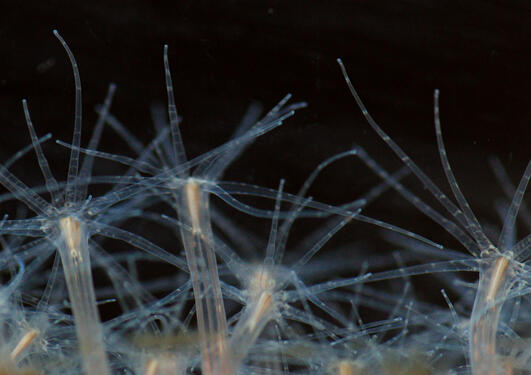Feast or famine: how sea anemones resize their bodies to survive
In a recent article, researchers from the Steinmetz group characterized the astonishing ability of sea anemones to adapt to food availability by growing and shrinking their body throughout their lives.

Main content
A team of researchers led by Kathrin Garschall from the group of Patrick Steinmetz at the Michael Sars Centre, in collaboration with Prof. Iain Johnston from the Department of Mathematics at UiB, focuses on quantifying and characterizing body plasticity in sea anemones. Their results, newly published in the journal Development, offer new insights into how living organisms adapt to their surroundings and survive without food.
When observing two species of sea anemones in the laboratory, Kathrin and co-author Daria Filimonova noticed that the animals displayed incredible size variations during their lifetime, growing when they have plenty to eat and shrinking when food is scarce. Most interestingly, these drastic changes in body size occurred in a stereotypical fashion. “I find the ability of sea anemones to adjust growth to feeding remarkable and it is entirely understudied”, Kathrin explained. “Most genetic model organisms don't show this plasticity, so there's nothing we can learn from models like Drosophila about this fantastic trait.”
“I find the ability of sea anemones to adjust growth to feeding remarkable and it is entirely understudied”
– Kathrin Garschall
This ability to match their size to their environment involves significant changes at the cellular level in the animals. To reveal these mechanisms, the team combined flow cytometry techniques to count and characterize cells, a technique spearheaded in the group by postdoc Eudald Pascual Carreras, with mathematical modelling. Their efforts revealed the most striking discovery of the project: the scale and speed at which this phenomenon occurs. “After feeding, the animal can within two days more than double the number of cells, and it can half the number of cells within a few days of starvation”, Kathrin explained. “Most economically you would assume that the animal eats them up again, but the lost cells may just be spat out into the water? Nobody knows yet.”
The multidisciplinary approach adopted by the team was instrumental in understanding their initial biological observations. “This is a really exciting example of where modelling and experimental approaches can mutually reinforce”, Iain Johnston explained. “It wasn’t just “oh let’s build a model too” or “oh let’s do some experiments too” – the combination of lab work and maths was required to make the scientific progress we did”. Kathrin agreed, adding, “The collaboration was extremely enriching for the project and solidified our observations. It allowed us to frame independent experiments into a process that can be quantified and to a large degree predicted.”

Juvenile Nematostella vectensis sea anemones feast on crustacean larvae.
In addition to characterizing the scale of body size variations, the study shows that sea anemones control this plasticity by regulating the cell cycle. When blocking the TOR pathway, a key nutrient sensing pathway, the team observed that the animals were unable to grow even when fed abundantly. “The accessibility of nutrients and the relay of this information through the TOR pathway has a major impact on whether sea anemone cells divide or not”, Kathrin explained. By promoting cell growth when food is available and slowing it down when food is scarce, the TOR pathway allows the anemones to survive in fluctuating ecological conditions.
By providing the first rigorous characterization of a phenomenon that had only been observed anecdotally, the study showcases the incredible adaptability of sea anemones. This work lays the foundations for future projects on the nutrient regulation of growth in animals, and opens up new avenues for scientists to explore how organisms might cope with changing environmental conditions.

